Digestive Bitters Market Research, 2032
The global digestive bitters market was valued at $1.4 billion in 2022, and is projected to reach $2.1 billion by 2032, growing at a CAGR of 4.5% fro 20m23 to 2032.
Digestive bitters are herbal preparations that are in use for ages to help with digestion and to promote good digestive health. They are traditionally used in Ayurveda medicines and Chinese medicines. They are made by combining different types of bitter herbs, roots, and other plants with a base of alcohol and vinegar. This form of liquid mixture is known as ‘bitters’ that can be consumed in small doses before or after a meal. The ingredients include herbs of wormwood, yarrow, calamus, cardamom, cinnamon, betony, rosemary, holy basil, burdock, dandelion root, elecampane, and licorice. Digestive bitters specifically help with digestion because of their bitter taste as it stimulates the bitter taste buds signaling the digestive system to generate more saliva which helps in better digestion.
MARKET DYNAMICS
The need for digestive bitters in many countries of North America and Europe has increased due to the lack of bitter-flavored food in their diets. The bitter taste deficiency has resulted in cultural health imbalances such as PMS (Premenstrual syndrome), hormonal imbalance, hypoglycemia, diabetes, and gastrointestinal diseases along with others. Moreover, bitters are not only medicines but also are necessary for human survival. They are considered very effective in treating digestive problems and can be taken as a preventive measure to avoid future anticipation of any gastrointestinal disease. According to the National Institute of Health (NIH), the digestive disease statistics for the U.S. shows that approx. 60 to 70 million people in the U.S. are affected by digestive diseases. Furthermore, the growing popularity of natural and herbal products for treating digestive problems has increased the overall consumer appeal leading to increase in Digestive Bitters Market Size.
Globally, there has been an increase in the trend of ‘self-treating’ and ‘self-directed’ consumers in the field of health and wellness. The self-diagnosis followed by self-treatment is very popular in today’s generation. The presence of various online platforms which supports the search of products related information has given consumers the capability to have control over their health and surge the Digestive Bitters Market Demand. The prevalence of self-medication accounts for 14% in South America; 13% in the U.S.; 11% in Australia & Germany; 9% in Sweden, the UK & Spain; and 8% in Switzerland, Mexico, and Italy. Moreover, herbal alternatives are always considered the best option for treating gastrointestinal problems. Owing to this, the demand for digestive bitters has increased significantly, increasing the Digestive Bitters Market Share.
The involvement of regulatory bodies plays a big role in the production and distribution of the herbal and natural product industry. The lack of standardization and limited FDA (Food and Drug Administration) control in the industry has created a challenging environment in the digestive bitters market. In addition, government authorities in many industrialized nations in North America and Europe regulate the efficacy and safety of herbal supplements. Moreover, the expansion of the digestive bitters market is being constrained by additional regulatory requirements, including informative labeling, market claims, and sustainable raw material sourcing, among others.
Although the demand for digestive bitters has increased, it still falls behind due to the presence of counterfeit products in the market. Counterfeit goods are posing challenges to manufacturers of digestive bitters owing to their toxicity, harmful content, and potential ineffectiveness in treating digestive issues. According to research, out of 5,957 commercial herbal products sold in 37 countries, 27% of them are found adulterated when they were tested against labeling and ingredients. In the digestive bitter sector, the threat of fake goods is also driving up competitiveness and altering consumer preferences.
The market for digestive bitters is being significantly impacted by the increased expenditure on R&D activities. As a result, businesses are getting assistance from the creation of novel products and technology to stay competitive in the market. The increased funding for the development of the digestive bitter market has provided innovative delivery methods such as capsules and powders which have been more appealing to consumers. Thus, the rising investment in R&D activities in the digestive bitters market is presenting an opportunity to reshape the digestive bitters sector.
The market for digestive bitters is greatly being impacted by the growth of e-commerce channels. The availability of a greater range of items to consumers through e-commerce channels has enhanced the market's awareness of digestive bitters. Consequently, with the entry of more brands and innovative products, the market has become more competitive. In addition, the e-commerce platforms have given small and independent consumers a platform to buy products. The market for digestive bitters now has a larger audience and a larger customer base owing to the increased e-commerce channel proliferation which eventually lead to Digestive Bitters Market Growth.
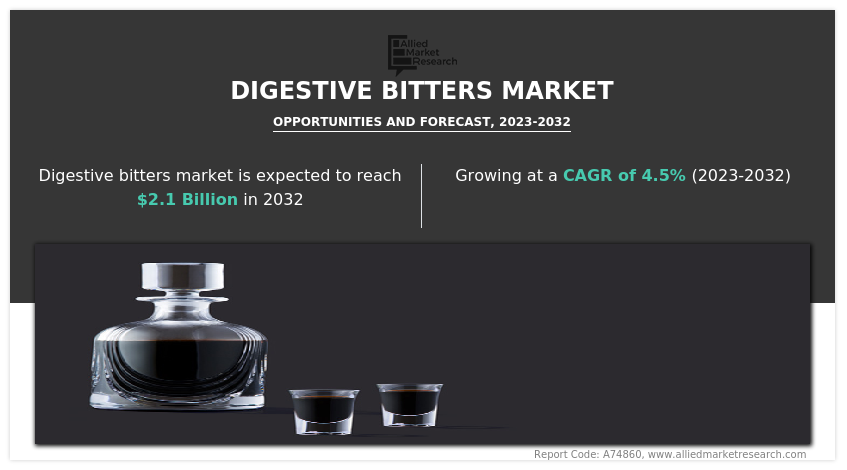
SEGMENTAL OVERVIEW
The digestive bitters market is analyzed based on type, packaging, distribution channel, and region. By type, the market is divided into true bitter, aromatic bitter, and nutritive bitter. As per packaging, it is segregated into plastic bottle, tetra pack, cans, and glass bottle. According to distribution channel, the market is categorized into supermarket, convenience store, over-the-counter, and online store. Region wise, the market is analyzed across North America, Europe, Asia-Pacific, and LAMEA.
SEGMENTAL OVERVIEW
The digestive bitters market is analyzed based on type, packaging, distribution channel, and region. By type, the market is divided into true bitter, aromatic bitter, and nutritive bitter. As per packaging, it is segregated into plastic bottle, tetra pack, cans, and glass bottle. According to distribution channel, the market is categorized into supermarket, convenience store, over-the-counter, and online store. Region wise, the market is analyzed across North America, Europe, Asia-Pacific, and LAMEA.
BY TYPE
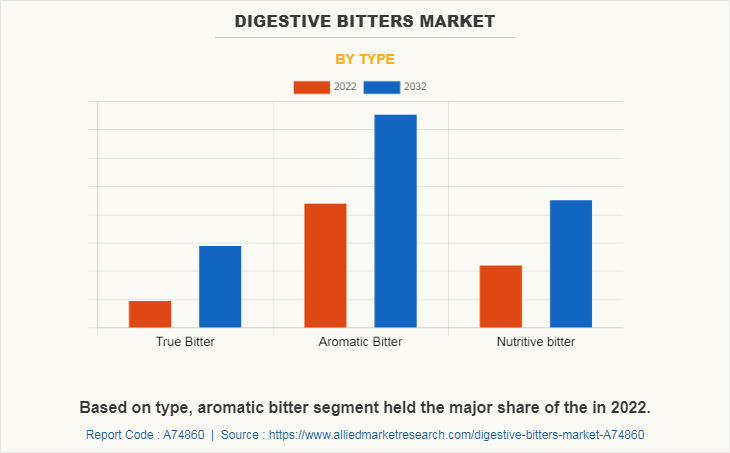
As per type, the aromatic bitter segment dominated the digestive bitters market in 2022 and is anticipated to maintain its dominance throughout the Digestive Bitters Market Forecastperiod. Aromatic bitter is composed of calamus (Acorus calamus), cardamom (Elettaria cardamomum), cinnamon (Cinnamomum verum), betony (Stachys officinalis), rosemary (Rosemarinus officinalis), and holy basil (Ocimum tenuiflorum) with a base of alcohol and vinegar. It is comprised of traditionally trusted herbal ingredients which are used as digestive aromatic stimulants, circulatory stimulants, and blood-sugar regulators along with being antibacterial, antifungal, anti-inflammatory, anti-viral, and gastrointestinal tonic. In addition, consumers have become interested in aromatic digestive bitters due to their pleasant aroma and diverse flavor profiles.
BY PACKAGING
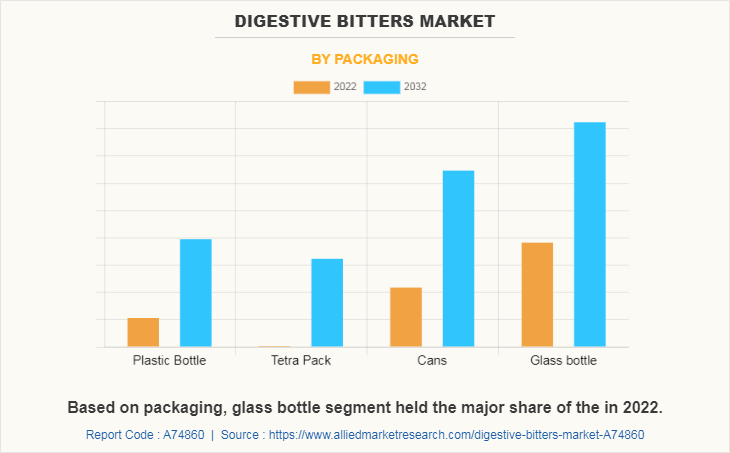
As per packaging, the glass bottle segment dominated the digestive bitters market in 2022 and is anticipated to maintain its dominance throughout the forecast period. The glass bottle is made from a blend of materials that makes it both sturdy and lightweight, ensuring that the contents are effectively protected from outside influences like light, oxygen, and bacteria. Glass bottles are one of the most common packaging options for digestive bitters. In addition, the glass bottles offer a visually pleasing presentation that increases the product's attractiveness to consumers.
BY DISTRIBUTION CHANNEL
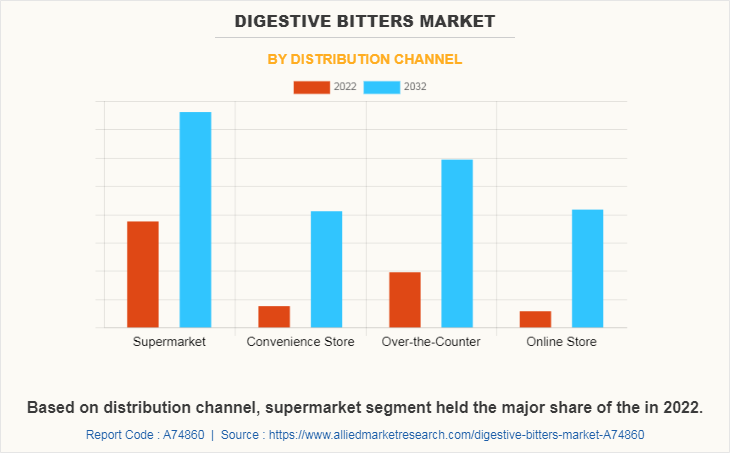
As per the distribution channel, the supermarket segment dominated the digestive bitters market in 2022 and is anticipated to maintain its dominance throughout the forecast period. Herbal supplements and natural products are majorly purchased in large retail formats such as supermarkets. Owing to their wide selection of digestive bitters products, supermarkets are the main retail outlet for digestive bitters. The products being sold come from various brands and have various formulations. Moreover, along with the nutritional and health supplement department, the health and wellness section also has digestive bitters. In addition, the staff in supermarkets offers pertinent information about the goods, boosting sales through this distribution route. As a result, consumers find this market to be quite appealing because it gives them a way to complete all of their shopping at one location, saving them time.
BY REGION
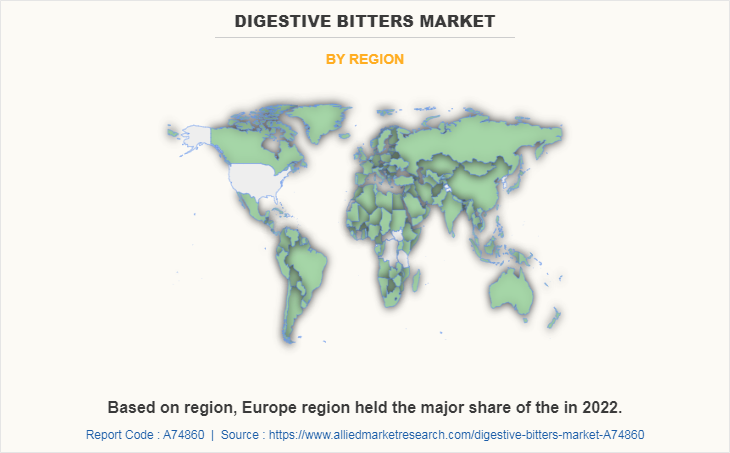
Region-wise, Europe is predicted to dominate the market with the largest share during the forecast period (2023-2032). Owing to the continual expansion of the European market, digestive bitters sales have significantly increased. Digestive bitters are becoming more popular in European nations as consumers turn away from goods produced by hazardous chemicals and follow the herbal remedy trend. Hence, the need for digestive bitters products is increasing. The several product variations present in the digestive bitters market that are recommended for various digestive ailments as well as combination of various formulas and chemicals in the market have made it easier for consumers to choose these items. As a result, manufacturers of digestive bitters are working hard to create distinctive goods that will catch consumers' attention and convince them to switch to using digestive bitters, which is increasing demand for the product in Europe.
COMPETITION ANALYSIS
The major players analyzed for the digestive bitters industry are Venus Bioceuticals Pvt. Ltd., Quicksilver Scientific, Inc., Urban Moonshine, Herbal Supplies Pty Ltd., Granary Herbs Ltd., St. Francis Herb Farm, Botanica, Zizia Botanicals, Arete Earth Based Wellness, Equinox Botanicals, Flora Health Shop, Hella Cocktails, Bittersberg, Nanton Neutraceutical Ltd,and Nature's Way.
Manufacturers of digestive bitters are always creating new products and formulas to satisfy the changing requirements of their customers. They make investments in R&D to create novel combinations of herbs with enhanced functionality, stability, and selectivity and create new applications for existing digestive bitters. While developing new products, enhancing production methods, and navigating regulatory requirements, manufacturers of digestive bitters frequently work with herbal supplement producers, regulatory organizations, and other industry players. Through these collaborations, manufacturers can increase their capacities, pool their knowledge, and create novel solutions.
In order to keep up with the rising demand for digestive bitters, manufacturers are improving their production capacity and cutting costs, which can involve both investing in new production facilities and renovating current ones. Manufacturers of digestive bitters may also merge with or buy other businesses in order to broaden their product lines, get access to new markets or technologies, or do both at the same time. Manufacturers can benefit from merging and acquiring businesses by expanding their product lines, gaining a larger market share, and enhancing their economies of scale.
In the upcoming years, it is anticipated that the market for digestive bitters would expand due to reasons including rising herbal supplements demand, more public knowledge of the advantages of natural products for health, and the development of newer and more effective digestive bitters. The market offers opportunities for innovation, collaboration, and expansion.
Key Benefits For Stakeholders
- This report provides a quantitative analysis of the market segments, current trends, estimations, and dynamics of the digestive bitters market analysis from 2022 to 2032 to identify the prevailing digestive bitters market opportunities.
- The market research is offered along with information related to key drivers, restraints, and opportunities.
- Porter's five forces analysis highlights the potency of buyers and suppliers to enable stakeholders make profit-oriented business decisions and strengthen their supplier-buyer network.
- In-depth analysis of the digestive bitters market segmentation assists to determine the prevailing market opportunities.
- Major countries in each region are mapped according to their revenue contribution to the global market.
- Market player positioning facilitates benchmarking and provides a clear understanding of the present position of the market players.
- The report includes the analysis of the regional as well as global digestive bitters market trends, key players, market segments, application areas, and market growth strategies.
Digestive Bitters Market Report Highlights
| Aspects | Details |
| Market Size By 2032 | USD 2.1 billion |
| Growth Rate | CAGR of 4.5% |
| Forecast period | 2022 - 2032 |
| Report Pages | 270 |
| By type |
|
| By Packaging |
|
| By Distribution Channel |
|
| By Region |
|
| Key Market Players | Urban Moonshine, Hella Cocktails., St.Francis Herb Farm, Quicksilver Scientific,Inc., Nature's Way Products, LLC, Zizia Botanicals, Equinox Botanicals, Herbal Supplies Pty Ltd, Nanton Nutraceuticals Ltd., Botanica, Venus Bioceuticals Pvt. Ltd., Bittersberg, Arete Earth Based Wellness, Flora Health Shop, Granary Herbs Ltd |
Analyst Review
The perspectives of the leading CXOs in the digestive bitter industry are presented in this section. The digestive bitters market is a dynamic and expanding segment of the global wellness food industry. Medical applications for digestive bitters include pancreas and stomach aids along with proper absorption of nutrients and minerals. For those who suffer from specific digestive diseases, digestive bitters are utilized as a digestive aid.
The CXOs further added that many factors, such as the increased demand for natural and herbal products, the popularity of herbal digestive aids, and the rising need for ethically sourced and clean-labeled ingredients are propelling the market for digestive bitters. The demand for digestive bitters is driven by shifting customer preferences and market dynamics, such as the effect of the COVID-19 pandemic on the herbal supplement sector.
A number of well-known players are active in the digestive bitters market, which is very competitive. Companies must differentiate their products, cut prices, uphold high standards of quality, and keep their consumers secure in order to succeed in this market. They need to focus on shifting customer tastes, shifting market dynamics, and shifting regulatory frameworks around the globe.
Thus, the market for digestive bitters offers business prospects for manufacturers. Companies need to be adaptable, creative, and focused on serving their consumers' demands if they want to succeed in this dynamic and often changing industry.
The global Digestive Bitters market was valued at $1,350.1 million in 2022, and is projected to reach $2,090.2 million by 2032, registering a CAGR of 4.5%.
The base year calculated in the Digestive Bitters market report is 2022.
The forecast period in the Digestive Bitters market report is 2023 to 2032.
The top companies analyzed for global Digestive Bitters market report are Venus Bioceuticals Pvt. Ltd., Quicksilver Scientific, Inc., Urban Moonshine, Herbal Supplies Pty Ltd., Granary Herbs Ltd., St. Francis Herb Farm, Botanica, Zizia Botanicals, Arete Earth Based Wellness, Equinox Botanicals, Flora Health Shop, Hella Cocktails, Bittersberg, Nanton Neutraceutical Ltd,and Nature's Way.
Europe holds the maximum market share of the Digestive Bitters market.
The true bitter segment is the most influential segment in the Digestive Bitters market report.
The company profile has been selected on the basis of revenue, product offerings, and market penetration.
The market value of the Digestive Bitters market in 2022 was $2,090.2 million.
Loading Table Of Content...
Loading Research Methodology...



